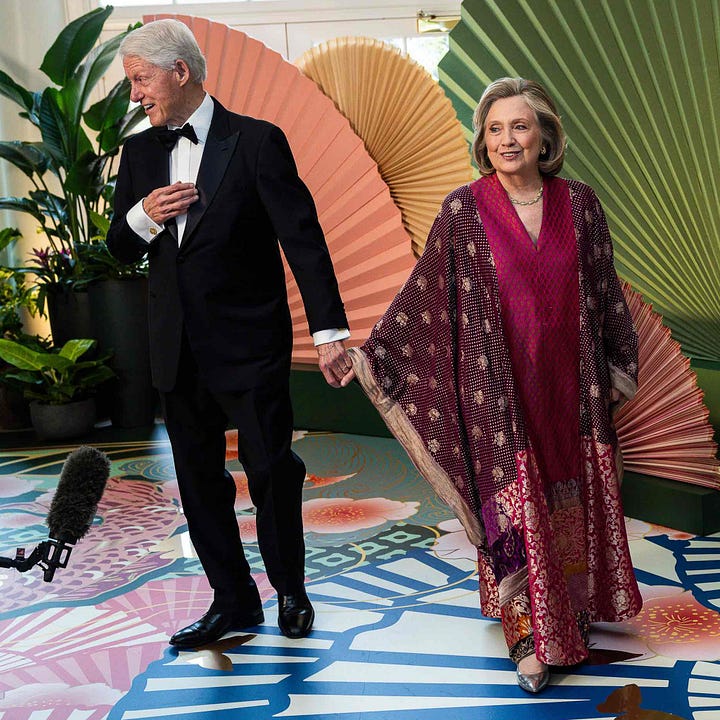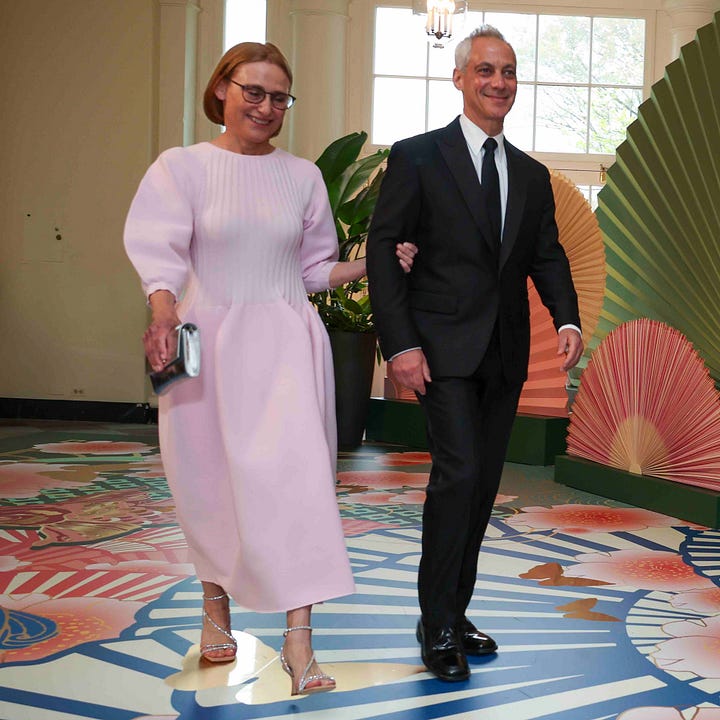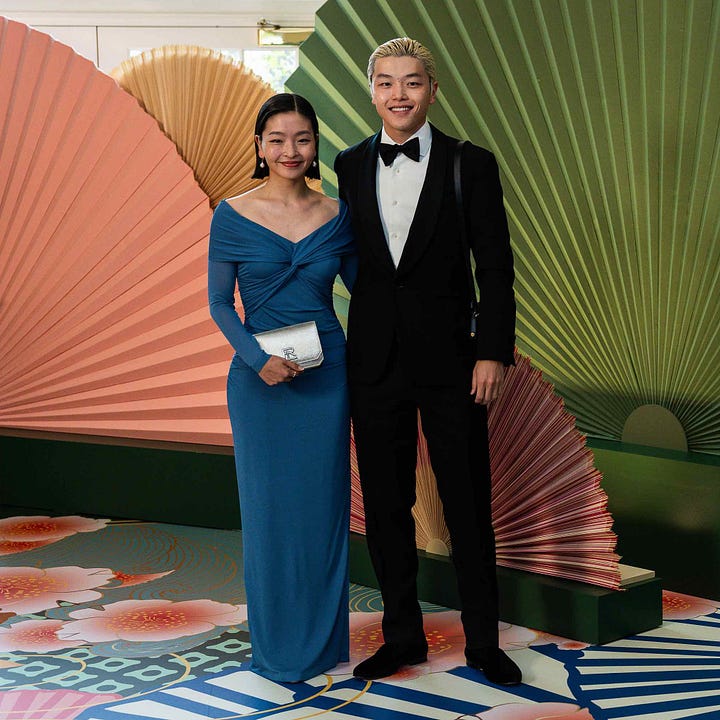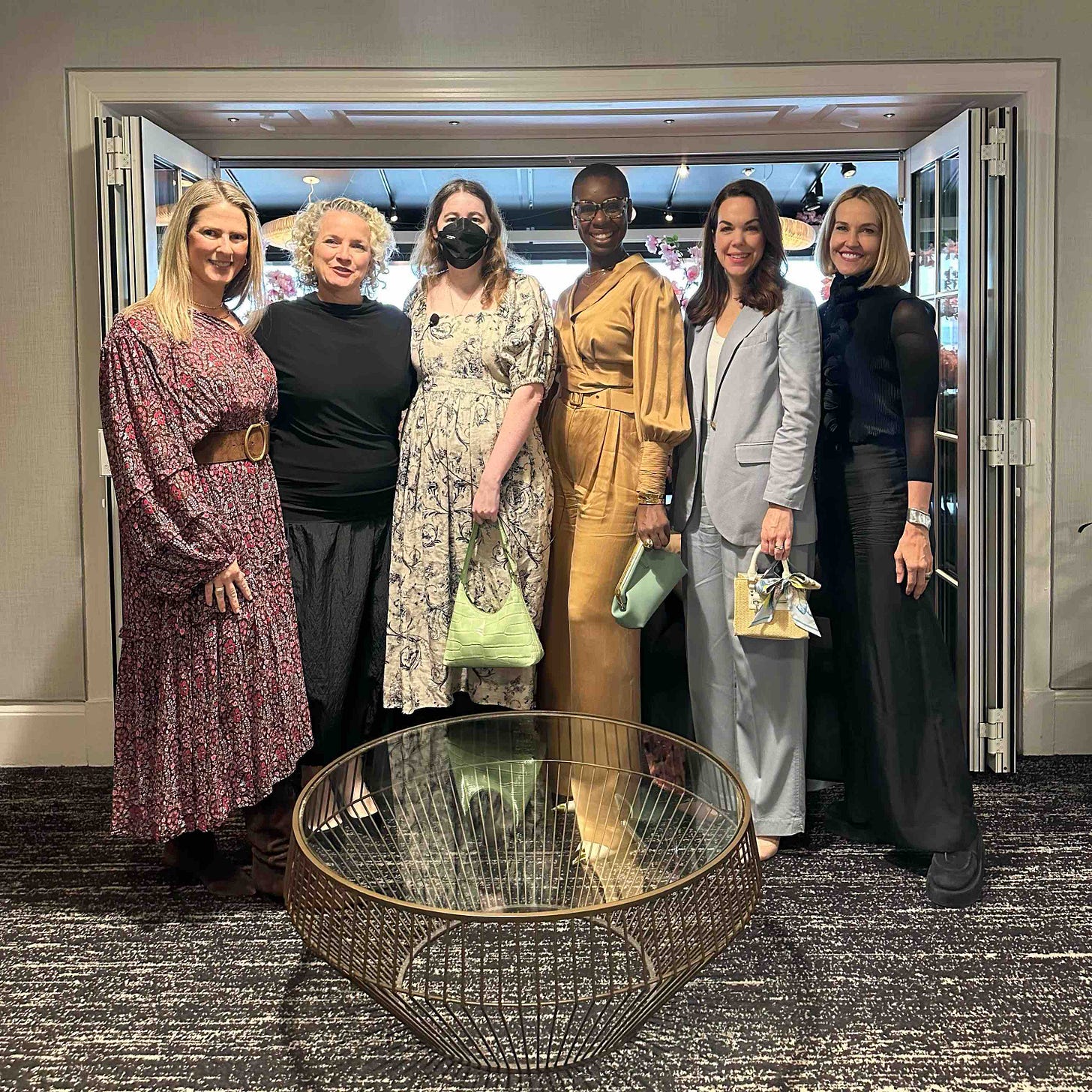Washington Enters the Fashion Chat
SMT on the Japan State Dinner, plus a recap of a panel on the politics of personal style.
What a week it has been for fashion in Washington! President Joe Biden and First Lady Dr. Jill Biden hosted their fifth state dinner Wednesday night, welcoming Japanese Prime Minister Fumio Kishida and his wife, Yuko Kishida. The evening saw more sartorial diplomacy — and fashion messaging — than we typically get from D.C. these days, with an embrace of red (a nod to the Japanese flag) and pink (invoking cherry blossoms).
Among my faves were former Secretary of State Hillary Clinton in a glorious caftan and the Bidens’ granddaughter, Naomi, resplendent in a cherry blossom cape confection by Bernadette. I also have to give a shoutout to Amy Rule, wife of U.S. Ambassador to Japan Rahm Emanuel, and her light pink dress (love the structured volume) by CFCL, a Japanese brand, as well as figure skater Maia Harumi Shibutani, whose Ralph Lauren gown perfectly matched the blue in the evening’s color scheme.




The fashion on Wednesday was also a reminder that the U.S. is in the midst of a heated election year. I can’t stop thinking about Biden’s beaded column gown by Oscar de la Renta, a storied American brand that has dressed many first ladies. Her ensemble beautifully coordinated with the dress worn by Kishida, a show of togetherness at a time when the administration is underscoring the strength of the relationship between America and Japan.
In pictures, both dresses read as purple, a color with many associations (including royalty and nobility, as well as calm and tranquility). In the U.S., the combination of red and blue is often chosen to represent unity or bipartisanship. Closer looks at Biden’s dress, posted on Instagram by the Oscar team, revealed it to be more blue leaning, with hand-embroidered crystals described as “sapphire.” With the ombré design, the gown looked as if it was blue morphing into purple — a notable effect as the general election begins in earnest.
I was thrilled to see this embrace of fashion (and hope we will get more as November nears). It also reminded me of an invigorating conversation I had during my recent trip to Washington, thanks to a panel called “The Power of Style: Personal Branding in Today’s World.” The wide-ranging style discussion, hosted by Hotel Washington and Fashionphile, touched on everything from what to wear to work to fighting the influence of the male gaze. It was timed to Women’s History Month, as was an exhibition in the lobby of the hotel highlighting notable women and the accessories they were known for (think: Princess Diana and the Lady Dior bag or Jackie Kennedy Onassis and the Gucci “Jackie” bag).
One point the panel kept coming back to was the stigma around fashion — which doesn’t seem to linger around an interest in, say, sports or music or food. How can we make style a more celebrated topic, welcomed as a worthy intellectual pursuit?
“We need to shout it from the rooftops a little bit more,” was my take. I want us all to be loud and proud in our discussion of fashion, a belief that’s at the heart of So Many Thoughts. I walked away from the nearly two-hour panel conversation with my head and heart full. We dove into everything from the evolution of workwear to finding one’s personal style amid the onslaught of trends, as well as why conscious consumption is so important and the need for female alliances.
Before the panel started, I asked if I could record it. Below you will find some of my favorite excerpts. It was nearly impossible to trim this down to newsletter format, but I did my best. My thanks to the panel organizers as well as my fellow panelists and the audience (who asked so many great questions!) — you have given me so much to think about.
PS: This newsletter may get cut off, depending on your email. To read it in full, click here.
The Politics of Personal Style
Excerpts from “The Power of Style: Personal Branding in Today’s World,” hosted by Fashionphile and Hotel Washington on March 28, 2024. The panelists included yours truly as well as (listed from left in the above photograph):
Moderator Kristin Moller, senior vice president at J Public Relations
Frédérique Campagne Irwin, president and CEO, National Women’s History Museum
Véronique Hyland, fashion features director at ELLE and author of Dress Code: Unlocking Fashion from the New Look to Millennial Pink(@niquepeeks)
Tashira Halyard, content creator at Politics & Fashion (@politicsandfshn)
Sarah Davis, founder and president, Fashionphile
Please note: This conversation has been edited and condensed.
On what it is about stylish women that we want to emulate:
Kristin Moller, moderator: The exhibit in the lobby showcases style icons from first ladies to global women leaders and the items they became known for and or inspired. Each of these women is recognized for their own personal style. Today, people all over the world are influenced by these women and other celebrities. What do you think it is about these public-facing women and their style that is memorable and inspiring others to emulate it or recreate it?
Sarah Davis, Fashionphile: I love looking at the history and these iconic women and the iconic pieces that are attached to those names. I love that Jane Birkin’s style is very casual. It’s not stuffy at all. In fact, if you look at the way she wore that bag, she beat it up. She had a few nice things and she made them her own.
And I love the story, in particular, about Jane Birkin sitting on the plane with Jean-Louis Dumas. He was leading Hermés, and she was complaining about how the Kelly [bag] just wasn’t big enough and didn’t have an internal zipper. [EH note: WWD has more on mid-flight conversation here, including how she “sketched out the design on a sick bag.”]
If you look at the heads of a lot of these design houses, a lot of men are designing things that are potentially not useful for women. When we are thinking about how we are dressing, women are looking at things that are practical, that feel good when we’re wearing them, that we feel confident wearing.
Tashira Halyard, Politics & Fashion: I am from the south and we have a history, I think Black women especially, of just putting it on. Especially when I think about the church-going women, the deaconesses, the mother of the church and what it means to oftentimes be a part of this marginalized class of people — by the way adorn yourself you would never know.
I remember being five years old, getting ready to get on the bus and my grandfather would always say, “Do you have on perfume?” So I’m spraying my grandma’s White Diamonds at six years old, going to the first grade. It is in our DNA in a particular way. When we see that reflection, especially by women in politics like Michelle Obama, it feels really good. I think it resonates with us, it lands.
On the evolution of workwear:
Kristin Moller, moderator: The range of acceptable businesses attire has changed and evolved over the last 20 years. With a hybrid work environment, so many people are working from home or they are going in and out of the office. It has become more relaxed and casual. Can we talk about what this means for women, particularly younger women? Because I know when I first started my career, I felt like I had to go to Ann Taylor and buy every shift dress I saw.
Véronique Hyland, ELLE: I am fascinated by the evolution of workwear and office wear and people kind of gravitating towards more comfort. We have seen people going back to officewear more than I expected. But there’s a sort of irony sometimes, of people wearing a big blazer but they’re wearing it out at night. The clothes have become kind of decontextualized.
I had that sense, too, of: You have to buy certain clothes for the workplace, you have to have a professional wardrobe, you have to dress like your superiors at work, dress for the job you want. But I think people feel a little bit more divorced from their employer. We are in a gig economy. People are a little bit more free agents, even if they are working for someone. You see that in people wanting to brand themselves and be individualistic in their workwear as opposed to just looking like some idea of what that person would have been 20 years ago.
Elizabeth Holmes, So Many Thoughts: I was just thinking about my first day at the Wall Street Journal. I remember what I wore: A black linen suit. And looking back, that was not my style, nor is it today, but it felt like the right thing to do.
And then when I went out on the campaign trail with the Journal, I packed a suitcase of almost exclusively black clothing. Part of it was practical, because I was living out a suitcase for 14 months and I needed everything to match. But I layered on a couple pieces that gave me confidence. I had this great red belted trench coat and I would pop the collar. Or I brought a knee-high boot with just enough of a heel that when I climbed on the bus I was like, “I got this. I can do this.”
I hope we’ve come a long way, as you say, especially in today’s hybrid work environment. There’s not that same need to conform, which I’m really glad about. But even in situations where there is, I think that you can start small with things that make you feel good — and layer on from there.
On expanding acceptance of style and fashion as resistance:
Kristin Moller, moderator: It’s really interesting what you were saying about color. It’s no longer always going to be black or navy. It’s okay to be a little bit different. Designers are looking at different silhouettes, willing to experiment with size and volume and different types of jackets or pants. Do you see any parallels with this shift and the rise of women in corporate positions?
Frédérique Campagne Irwin, National Women’s History Museum: When I started in management consulting almost 30 years ago, I was told not to carry a purse. I was told to try to emulate — talk, walk, etc. — my male colleagues. I think we have seen this shift in terms of what women feel comfortable wearing at work.
To put a little historical perspective on it, for those of you who grew up in this country or who have kids in the curriculum today, only 15% of what is taught in our social studies and historical curriculum is about women and women’s achievement. Half of that 15% is in a domestic capacity, so Martha Washington was married to George, and that’s what you hear. There are very few women, whether they’re in business, in government, in policy, etc., that are not only talked about historically, but also showcased. Only 8% of our national monuments and statues represent women. President Biden signed an executive order to change that, but there is just very little representation.
We have had this interesting last quarter century, where you have had more women entering the workforce and yet men being like, “Ok, come on in here, but this is how we do it.”
Tashira Halyard, Politics & Fashion: I am so interested, based upon what Frédérique just mentioned, about the structures that are at play that made us feel that we had to adopt particular norms in order to be taken seriously at work. That’s the place that I think we’re at today, generationally, just really pushing back and determining ways in which we can show up healthy and whole in work environments that feel good for who we are.
For me, in many ways, it is an act of resistance to take up space in a very real way. I think about Audre Lorde, who once said, “Caring for myself is not self-indulgence, it is self-preservation, and that is an act of political warfare.” Self care is style for me. It is who I am and is my calling card to the world. Whatever gets in the way of that, whatever impedes that, needs to be questioned and I hope dismantled.
Kristin Moller, moderator: As women, we gravitate towards style. And I think what you said is absolutely true, we are using it as a part of self-expression.
Elizabeth Holmes, So Many Thoughts: It’s also used against us. I’m thinking of Princess Diana and Prince Charles. And as their marriage was crumbling and the attention around her was skyrocketing, he used fashion against her. He would say publicly, “Oh, she’s going to go shopping.” It was meant to cast her as frivolous.
And I hope we’ve come a long way. But when I was covering fashion at the Wall Street Journal, I was up against a lot of male editors who were constantly questioning my stories or wanting me to bring in the male perspective or trying to dismiss it — when it’s a multi-billion dollar industry. Everybody gets dressed every day.
On the universality of fashion:
Kristin Moller, moderator: Véronique, in your book you talk about how everybody has to wear something every day, so it is part of everybody’s everyday life, yet it’s dismissed. Meanwhile, men are enjoying golf and other things that might also seem like a waste of time.
Véronique Hyland, ELLE: When people love to tell me that they don’t care about fashion, they’re not interested in it, they don’t care what they wear — it’s like, that’s great. You don’t have to be. But you can’t really opt out. Even if you’re a nudist, you have to go to the DMV sometimes.
Keep reading with a 7-day free trial
Subscribe to So Many Thoughts to keep reading this post and get 7 days of free access to the full post archives.









